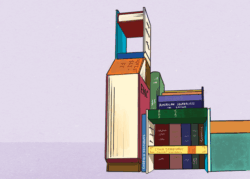Lauinger Library has served as a main study space on Georgetown’s campus for over 50 years, but now, administrators are considering an upgrade to the dated facility.
“Students come to the library more today than they did in the past, and I think it’s because the library is a gathering place that serves both social and scholarly needs,” Harriette Hemmasi, dean of the library, said. “This blending of social and scholarly encounters is so critical for the success of students. Once the library is renovated and the space is improved, I believe that it will draw even more students.”
The building’s five floors and collection of more than a million volumes were intended to facilitate a space for students to research, socialize, and focus on academic tasks. As use for the library has adapted to changing formats and the building itself has aged, administrators, including Provost Robert Groves, have discussed plans to remodel the space.
With an estimated $100 million price tag, the project’s major goals include creating a more open floor plan, redesigning individual and group study spaces, and reducing the number of printed books in the library. The renovation will be completed using a phased approach so that Lau can continue to remain open to students.
When Lauinger was constructed, print collections were its most important aspect, and spaces like the fifth floor Booth Family Center for Special Collections continue to house rare volumes. The Durkin Collection and McGhee Collection, among others, are still valuable sources of information but no longer the reason why most students spend time in the library, according to Hemmasi. Rather, students tend to seek out research through online databases, which comprise 80 percent of the library’s collections budget.
Although the remodeling process is yet to officially begin, administrators have an idea of changes they would like to implement. Construction will likely start with the Pearce Reading Room on the third floor. Preliminary plans include removing the back wall of the room—which currently connects to a staffing area—to create an opening through which students can see the Potomac.
“We think about Pearce as a model or example of what the remaining floors might look like—openness, installed technology such as a large visualization wall to show student work and materials from special collections, and updated furniture and finishings,” Hemmasi said. “The building has a certain charm, but it’s more than 50 years old.”
The original layout of the library allocated 60 to 70 percent of floorspace to books. The renovation process will include sending less-used titles to the off-site shelving facility that Georgetown shares with other members of the Washington Research Library Consortium. Approximately one million volumes are currently stored in this facility. Even though physical copies will be relocated, they will still be available through the library database, HoyaSearch.
Hemmasi believes this space is better suited to be a variety of collaborative areas for students to study and socialize. “We need noisy spaces. We need quiet spaces. We need more spaces for group studying,” she said.
Ella Hetfield (COL ’23), director of Midnight MUG, is in the library often and has similar ideas of what an improved model of Lauinger could look like.
“I would like to ensure that we provide study break options within Lau, such as through a Corp location like Midnight,” Hetfield said. “It’s important to prioritize spaces like the Maker Hub and Writing Center and give them more foot traffic. I think they are underutilized.”
Ideas such as Hetfield’s will contribute to the reimagining of Lau, as Hemmasi and others involved in the project hope to utilize student feedback to guide the renovation process. The library held three information sessions to gauge student opinion and interest. They are seeking other forms of survey feedback through social media.
“The focus groups have been a great way for the librarians and others in the renovation process to get a student perspective, and I hope that that kind of community engagement continues as they move forward in the process,” Hetfield said. “There’s no point in building a library that doesn’t fit the needs of the students who are going to be using it.”
Many students believe that going to the library is essential to productively learn and accomplish tasks. Studying at Lau can add variety to students’ routines and encourage socialization with peers.
“I have friends who go every day, and will even stay there past 12. I think it is important to have a place for students to study at, even late at night,” Dora Pisula-Litoff (COL ’25) said. “It can be really helpful just to get out of your room.”
From manuscript collections to 3D-printing, Lauinger has experienced more than five decades of technological progress. As the demands of students change, faculty and staff believe the library should as well. Although there is no official timeline, administrators are optimistic that some of these changes will materialize within the next few years.
“This library was built for a different time and a different use, and that’s the reason it’s so important that we make a change,” Hemmasi said. “We can reimagine both what Lauinger needs to be and what it could be.”






I hope they incorporate a more Romanesque-style exterior to better compliment the beauty of Healy Hall and the other buildings at the front of the campus. I think it definitely should blend in better with the other buildings you are greeted with when you walk through the front gates of campus. Excited to see the final sketch!